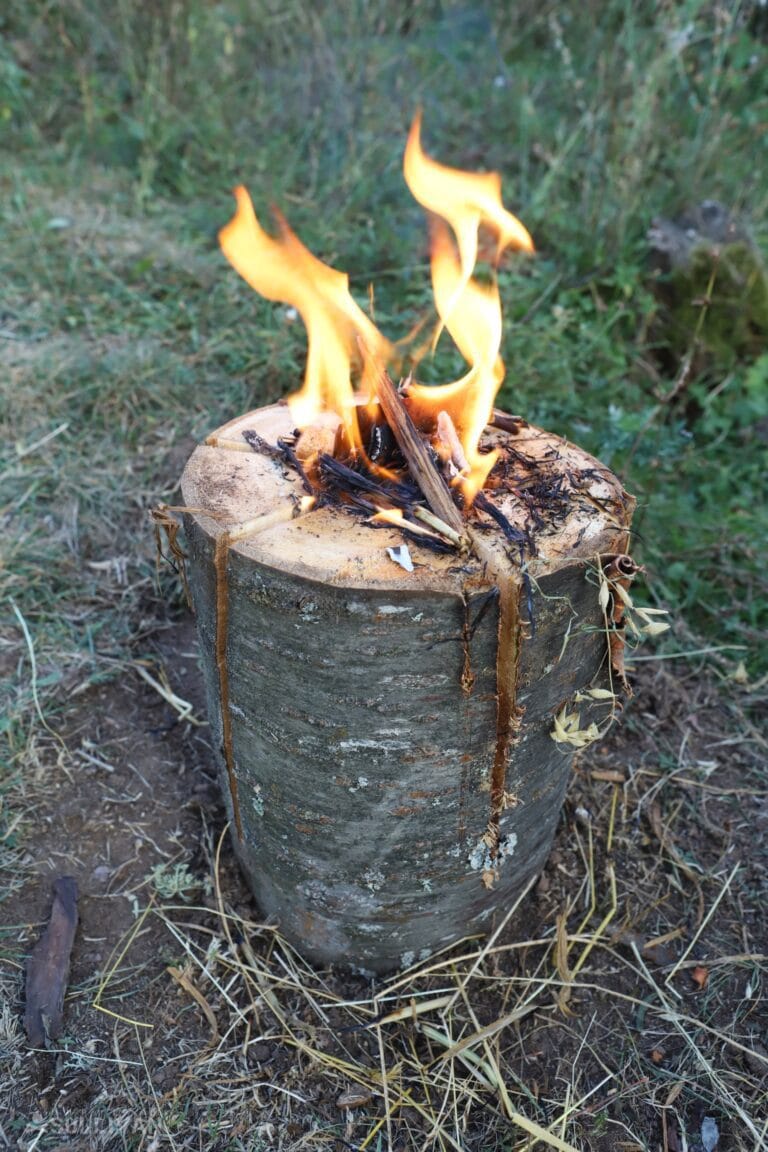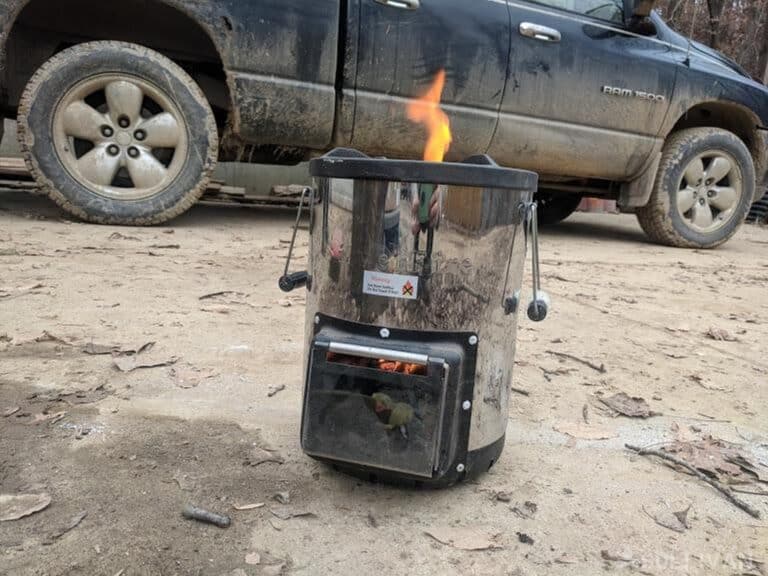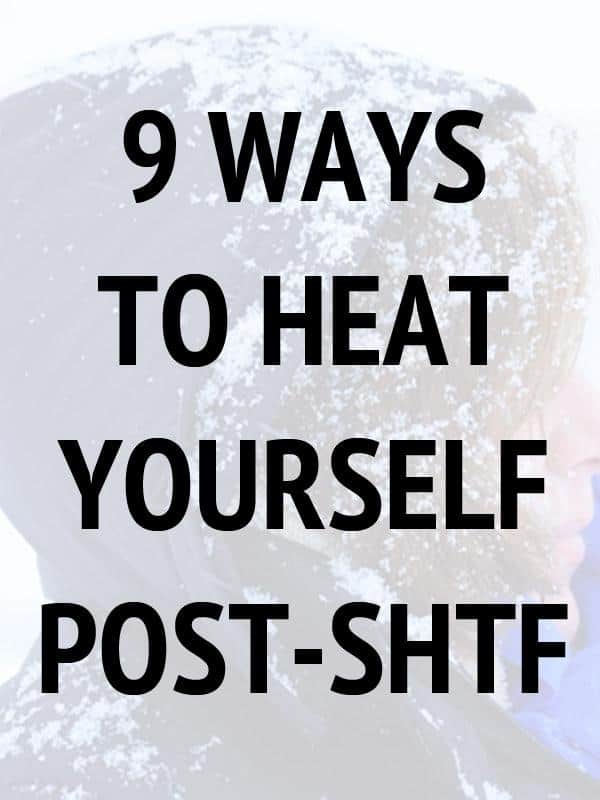When SHTF, the first thing most people will focus on is trying to find food and water. But, if you’re a prepper you know that while water is critically important to your long-term survival, the ability to stay warm and to heat yourself post-SHTF can mean the difference between life and death.

Frostbite and hypothermia can set in very quickly, in less than five minutes on cold days when the wind is blowing, and even in moderate weather if you are wet.
So, one of the major things that preppers need to plan for when SHTF is how to stay warm in your home or other shelter and how to heat yourself if you are stranded outdoors unexpectedly for any length of time.
In fact, knowing and planning for ways to heat yourself and stay warm is important even for short-term emergencies like a power outage.
Understanding how to stay warm is critical to being able to heat yourself post-SHTF. The best way to keep your body warm is to prevent heat loss as much as possible.
Keeping Yourself Warm
Keeping yourself from freezing is almost like a dance. There is a general rhythm but certain nuances to each situation. In most cases you should have at least two ways to keep your body warm. Here are some of the best ones you can use in a survival situation.
Add Layers Between You and The Ground
Prevent the direct transfer of heat from your body by using a sleeping bag if you are outdoors or a pad of thick blankets or thick layer of dry debris between you and the cold ground.
Something like a closed-cell foam pad acts much differently than a bed made of coniferous boughs. A foam pad acts like a thermal break in which the cold cannot penetrate through the material.
An inflatable pad or boughs from a tree work differently in that they heat the space between you and the ground. This form of insulation works to keep the cold from seeping into you from the ground.
Anything you can put down between you and the ground or use to raise yourself up off the ground will help to slow your loss of body heat and will keep you warmer.
Cover Your Skin
Body heat is lost when air moves over exposed skin, also called wind chill. We all know that if you are outside it’s a good idea to have gloves, a scarf, and insulated boots in the colder climates.
If your mother was anything like mine, she told you to cover your head because she was convinced that you lose most of your body heat through the top of your head.
This old wives’ tale has actually been proven false in recent years. In truth, you lose the same amount of heat through the top of your head as from any other body part with a similar area of exposed skin.
But even though you don’t lose most of your body heat through your head, you can still have a body heat loss of up to 10% by leaving your head exposed.
So, in addition to covering other body parts, covering your head with a hat, blanket, or scarf, can help you retain body heat and therefore stay warmer.
If you find yourself in a survival situation without layers, or if you are still cold, you can use a heat reflecting blanket such as a space blanket or even paper, newspaper, or any kind of dry debris such as grass or leaves to stop wind from getting through your clothing to your skin if you have nothing else.
Layer Up
Another good way to heat yourself post-SHTF is to always wear layers of clothing. Layers help to trap the heat your body dissipates naturally.
When clothing in layers, the layer closest to your skin should be something that breathes and wicks away moisture, such as merino wool or a synthetic blend.
Any kind of barrier, such when mom used to put plastic bags over your sock feet, will limit the heat loss by evaporation.
The middle layer serves as extra insulation. It needs to be something that moist air can pass through. Fleece, down, even wool are great options for the middle layer. The outer layer is the shell and should be both breathable and waterproof.
Cotton is by far the worst material to wear in a cold situation. It is not breathable which means you’re going to sweat more and the material won’t dry.
Not only that but it weighs almost double the weight when it’s wet. This means all of your sweat will weigh you down, make you cold, and never dry.
The layers should be thin so that your body can easily heat the layers in between. Thicker material means it takes more body heat to warm it up.
If it’s cold enough then the chill can set in and stay in if you can’t ward it off. If your layers are thin enough it enables you to stay mobile. You don’t want to be bogged down by a bulky snowsuit.
Boiling Water
A Nalgene Bottle filled with boiling water and slipped inside an old wool sock will keep a bed warm for up to 10-12 hours. You can also heat bricks or rocks in a fire or stove and put them under your blankets near your feet and they will radiate heat.
Sharing Body Heat
If you have at least one other person in your survival group, you can cuddle up to share body heat. If there are more than two of you, put those most vulnerable to the cold between the others, those in the middle of a body heat sandwich are the warmest.
It is best to sleep huddled in groups or up against each other. As we sleep our body temperature cools off due to reduced bodily functions. The combined heat will do wonders in keeping you all warm during a cold night.
Hand and Body Warmers
Disclosure: This post has links to 3rd party websites, so I may get a commission if you buy through those links. Survival Sullivan is a participant in the Amazon Services LLC Associates Program. As an Amazon Associate, I earn from qualifying purchases. See my full disclosure for more.
If you’ve planned ahead and included a few air activated hand warmers or even body warmers in your bug out bag, you can use these to help stave off the cold and heat yourself in a survival situation.
If you didn’t plan ahead, you can even make your own hand warmers by filling pockets of insulating material such as fleece or flannel with grains of rice and heating them for five minutes on the top of a wood stove.
If you really didn’t plan ahead you can take some cattail fluff and hold it in your hand. You’ll start to feel the warmth within seconds as you heat up the cotton-like fluff.
Foods That Will Warm You Up
Believe it or not, there are certain foods you can eat that will kickstart the Diet Induced Thermogenesis (DIT) process in your body. As you digest certain foods your body begins to produce energy. When the mitochondria get involved in digestion, heat is produced.
So, one of the ways to “heat yourself” is to eat root vegetables such as kale, potatoes, cabbage, and sweet potatoes, or carrots, which are more effective in raising internal heat as you digest them.
Other foods that help raise internal body temperature include peanuts, brown rice, coconut oil, and fresh ginger. Hot peppers increase circulation and can raise body temperature slightly.
Warm meals may provide immediate short-term temperature increase and possibly stop the shivers long enough for you to make a more substantial meal, but it won’t last near as long as eating raw vegetables.
Eat Fat And Protein
Fatand protein are another food source that will fire up the DIT, primarily found in meat. The difference is that the energy output is increased when consuming meat as opposed to low density carbohydrates.
Additionally, the energy is longer lasting which means you can go for longer periods without feeling the need to eat and replenish your energy. In colder situations having a good source of meat is important to keeping warm.
Keep Moving
If you’ve spent any amount of time outdoors, you probably know that you feel warmer when you are moving than when you are sitting still. This is because heat is generated by muscular work.
To put it simply, movement causes your body to produce heat. So another way to heat yourself post-SHTF is to keep moving as much as possible.
Make sure to monitor your activity. The old saying is that you want to stay comfortably warm when sitting still and comfortably cool when working or exercising.
This means that if you are sitting still then make sure you have the proper layers so that you can stay warm and if you are working then to not overdo it and sweat. Activity is important but so is not sweating and then getting cold because of it.
Heating Your Home or Shelter
Once your body is warm you can get to work on making a shelter as warm as possible so that you have a place to go when it is bitterly cold outside. Check out some of the ways you can keep your shelter warm from the elements.
Fireplaces and Fire Pits
Fixtures installed in advance, such as a fireplace, can be used to heat your home post-SHTF well. But if you have the option to choose, go for something like a wood burning stove, wood-fired cookstove, or even a rocket stove heater, or a potbelly stove.

These can not only be used to heat your home more efficiently than a fireplace, but they can also be used more easily to cook food and heat hot water in a long-term SHTF situation. Get a stove that can use a variety of fuels including wood, peat, coal, and even used vegetable oil so you can use whatever is available to you.
Additional things you can do in advance of a SHTF situation include ventless gas wall heaters which kick on if you lose your main heat source.
In an outdoor space, a campfire, Swedish log fire, fire pit, Kotatsu (Japanese fire table) or chimenea can provide warmth for those around it. The type of outdoor fire you use will largely depend on whether you plan ahead and whether you are on the move or have the luxury of bugging in.
Portable Heaters
Kerosene
Many people are familiar with kerosene heaters. Some of them do not require electricity but instead use kerosene fuel to operate. The larger ones are 23,000 BTUs and will be great for larger spaces.
For those with smaller spaces or who are on a budget, the smaller 10,000 BTU heaters work well and use less fuel. Make sure you buy and install battery powered CO2 detectors if possible and use plenty of ventilation.
Propane
Another option for a portable heater are the Mr. Buddy and Little Buddy propane heaters. These run using propane tanks from 1 pound to 40 pounds.
They are portable radiant heaters that are efficient and do a great job at heating.
The larger heater has connections for two tanks, the smaller has one connection. The reflector model screws directly to a 20-pound tank.
You can find old tanks at flea markets or yard sales or even abandoned in a SHTF situation. Just one pound of propane will operate the heater for 5-6 hours on the low setting.
Wood Portable Stoves
The portable Frontier Stove or Traveler Stove are two other ways to heat yourself. These can be used outdoors or even inside a tent or yurt with the proper fire safety precautions.
You can also find twig stoves on the market which use any twigs you can find on the ground.
They are small metal stoves that break down into a small kit that can be carried in any backpack. An amazing choice if you need to head a small outdoor space
Use Candles
Obviously, propane lanterns, oil lamps, kerosene lamps or even candles are not designed to be used for heat.
But they can give off a small amount of heat that can raise the temperature in their immediate area if you need to heat yourself post-SHTF in a survival type situation.
Using lanterns for heat inside an enclosed space or for an extended period of time should be a last resort option, but is not recommended due to safety issues.
Close Up Any Noticeable Drafts
One of the biggest ways to stay warm in your home and heat yourself is to stop drafts coming in and stop heat going out.
- Insulated Window Treatments
- Bubble Wrap on Windows
- Caulking around windows
- Use a draft blocker or towel on the bottom of exterior doors.
- Add weather stripping around doors
- Install storm doors
- Use plastic window film for windows and sliding glass doors
Final Words
The best way to heat yourself post-SHTF of course is to plan ahead as much as possible so that you have a heat source that doesn’t require electricity and is sustainable for a longer-term period.
But it never hurts to be prepared with the knowledge of some of the other methods to raise your body temperature. If you get caught without a backup heat source or if you have to bug out, the odds will be more in your favor.


Born and raised in NE Ohio, with early memories that include grandpa teaching her to bait a hook and watching her mom, aunts, and grandmothers garden, sew, and can food, Megan is a true farm girl at heart.
For Megan, the 2003 blackout, the events of 911, and the increasing frequency of natural disasters like Hurricane Katrina, spurred a desire to be more prepared. Soon to be living off-grid, this mother of four and grandmother of ten is learning everything she can about preparedness, survival, and homesteading.

A little military cold weather survival trick is to eat your big meal of the day immediately before you go to bed. The resultant increase in body heat caused by digestion will help keep you warm during the night.
great suggestion! Thx for sharing